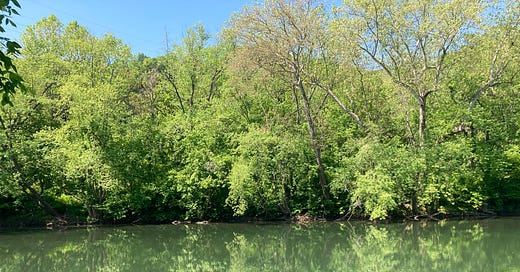Heraclitus is famous for teaching us that we cannot step into the same river twice. We conclude, naturally, that this is because the river is constantly flowing, changing. The river is different, each time our foot enters new waters that have swept in to replace the old. But if Hume is correct, or the Buddhists, or if there is truth to the stream of consciousness, the elusive bird that breaks from its perch only to light on the next illuminated moments, we might ask also after the foot.
If the river itself is different it is, in part, because the foot has stepped in it. To step again, already to say “again,” indicates the step that came before. It is the river that had been stepped in so that it may be stepped in again.
The foot, then, is the foot that stepped before. Stepping again, it is a foot that had already been in the river. The first step, if we think of “firsts” strictly, is not preceded by another step. The first step is one with nothing prior to it, no previous step. It is by definition a novel event, without precedent, and so the foot that takes the first step is one that had not been in the river before.
The foot that takes the second step, and so steps again, is the same foot but also more than the foot that stepped first. And so the feet, since that is where our conclusion leads, are not identical. We might say that we cannot put the same foot in the river twice.
There is always something more, overflowing the bounds of identity.
Like philosophy, the river is poor folks’ luxury. It is a public good. You can swim, fish, boat, and float the river from many access points, like the one where my grandfather keeps his camp. You can put an inner-tube on the river there, just below Mexico Farm, and float to Oldtown or farther, to Green Spring, West Virginia and east.
The river is a pastime and a passing of time. Kant said that drawing a line is the first representation of time, a primal way of conceptualizing time as flow, duration, and direction. The river draws its own line and draws us along with it. You can see the eddies and bubbles, the rings and ribbons of the current blurring the image of the trees reflected in the water. Debris, driftwood, the occasional bag or shoe, pass from right to left and then recede.
On the river itself, the bank passes along. The landscape changes, opens and closes, the mountains slowly rising and falling, a fence post marking the time, or a bend where sediment piles up in pebbled banks. One can of beer from the cooler and then two. Another fish on the line. How many fish do you think we’ve caught?
If you said more than one remember I said “another one,” which is one but more than one, an other one.
The river marks time by its high-water marks. How many years since the last flood. How high’s the water, higher than last time or no? How long since the flood control was put in, will it last? How long since the river was safe to drink?
The uses of the river change. When settlers first began taking land in Western Maryland, when timber and furs, then coal were the major resources flowing east, the river was the main line of transport. From Cumberland to DC, the Potomac carried resources to and fro. The canal and the railroads were really ways of getting around the limits of the river while also building upon its geographic traits and the path it cleared already through the mountains. Those other modes of transportation changed the traffic on the river again.
Things were freeing up. The river could be for other things again.
People have always been drawn to the river. Downtown Cumberland now sits on occupied land at the confluence of Wills Creek and the Potomac, where the village of Caiuctucuc was once. The river, for all its change, persists. It’s draw persists.
My mother took my young son to the river bank. She held him as he pointed out, to the water or the opposite shore. He splashed and laughed and I showed him crawfish scurrying through clouds of mud in a little inlet where water eddied around a sunken log. My grandfather arrived with a riding lawn mower in tow and a new accessory — an oxygen tank — dangling form his side. He breathed heavy as he lowered the trailer gate and climbed onto the mower. The machine was as old as I was, bought from Sears in 1984.
Time keeps on by the river. The river keeps its time. This is time and its passing and I have come once again to bear witness.
< Previous post in this sequence



